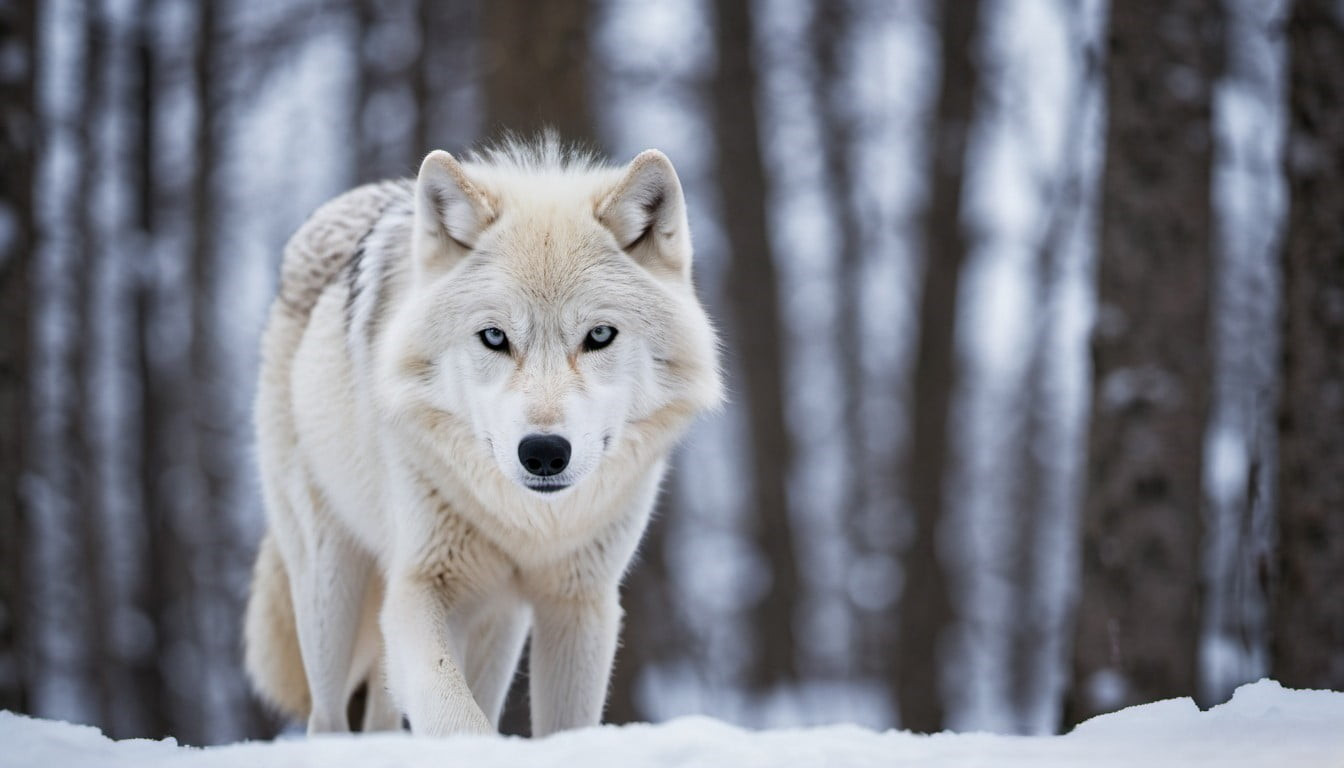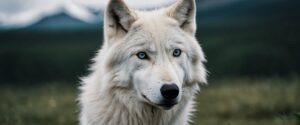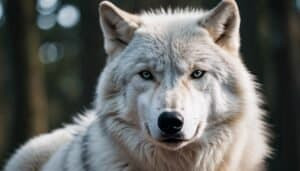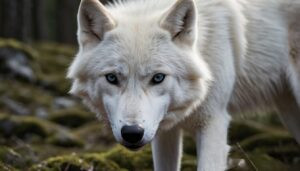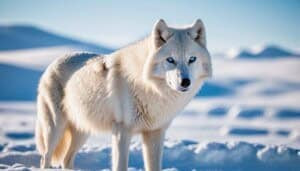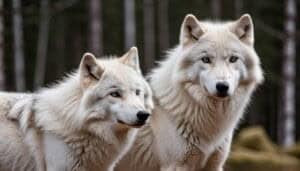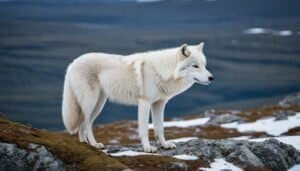Introduction
The Arctic wolf’s sense of smell plays a crucial role in its survival in the harsh polar environment. In this article, we will explore the unique olfactory adaptations of the Arctic wolf and how its sense of smell is influenced by its icy habitat
We will compare the Arctic wolf’s olfactory capabilities with those of other canines, including gray wolves and domestic dogs, examining differences in brain structure and functionality
Additionally, we will discuss the impact of the Arctic wolf’s sense of smell on its hunting behavior and territorial communication. Finally, we will delve into recent scientific research to uncover relevant findings and conclusions about the Arctic wolf’s remarkable sense of smell
Development and Adaptations of the Sense of Smell
Understanding the olfactory prowess of the Arctic wolf begins with exploring the specific adaptations and environmental influences that shape this remarkable sense. These adaptations are essential for their survival in the extreme conditions of the Arctic
Olfactory Adaptations of the Arctic Wolf
The Arctic wolf, also known as Canis lupus arctos, has developed several unique olfactory adaptations that differentiate it from other canines. These adaptations are crucial for locating prey, communicating with pack members, and navigating the vast, icy expanses of their habitat
One significant adaptation is the increased number of olfactory receptors. Arctic wolves possess around 300 million olfactory receptors, a trait shared with other wolves, but their functionality is honed for the Arctic environment. This high receptor count allows them to detect faint scents over long distances, which is vital in a landscape where prey is scarce and widely dispersed
Another adaptation is the structure of their nasal cavity. The Arctic wolf’s nasal cavity is larger and more complex than that of many other canines, with numerous folds that increase the surface area for scent detection. This enhanced structure enables them to analyze a broader range of scents, distinguishing subtle differences in odor that might indicate the presence of prey or predators
Influence of the Polar Environment on the Arctic Wolf’s Sense of Smell
The extreme conditions of the Arctic have a profound impact on the development and functionality of the Arctic wolf’s sense of smell. The cold temperatures and vast, open landscapes require these wolves to rely heavily on their olfactory capabilities for survival
In the Arctic, the ability to detect scents over long distances is essential. The frigid air can carry scents further than in warmer climates, but it can also dull them. Arctic wolves have adapted to this by developing a keener sensitivity to even the faintest odors. This heightened sensitivity allows them to track prey, such as musk oxen and Arctic hares, which are often hidden beneath layers of snow
Moreover, the polar environment’s lack of visual landmarks means that Arctic wolves must depend more on their sense of smell for navigation. They use scent markers left by other pack members or their own to find their way through the seemingly endless white expanse. This reliance on olfactory cues is crucial during the long Arctic nights and snowstorms when visibility is severely limited
The Arctic wolf’s sense of smell is also pivotal for social interactions within the pack. Scent marking helps establish territories and maintain social hierarchies. Each wolf has a unique scent profile that conveys information about its identity, health, and reproductive status, facilitating complex social dynamics essential for pack cohesion and cooperation
Comparison with Other Canines
To fully appreciate the Arctic wolf’s sense of smell, it’s insightful to compare it with that of other canines, such as gray wolves and domestic dogs. This comparison highlights the unique adaptations and capabilities of the Arctic wolf
Sense of Smell of the Arctic Wolf vs. Gray Wolf
Gray wolves (Canis lupus) and Arctic wolves share a common ancestor and many physiological traits, but their olfactory capabilities differ due to their distinct habitats. The gray wolf, inhabiting forests, mountains, and plains, relies on its sense of smell for hunting and communication, much like the Arctic wolf
While both species have a high number of olfactory receptors, the Arctic wolf’s receptors are particularly adapted to function optimally in freezing temperatures. This adaptation allows Arctic wolves to detect and interpret scents even in the harshest conditions, where gray wolves might struggle
Additionally, the Arctic wolf’s nasal cavity structure is more specialized for filtering out the overwhelming cold air, which can interfere with scent detection. In terms of behavior, the Arctic wolf’s sense of smell plays a more critical role in its survival strategies. In the tundra, where visual cues are minimal and prey is sparse, the ability to detect scents over vast distances becomes paramount
Gray wolves, on the other hand, often hunt in more densely populated areas with varied terrain, where their olfactory skills, while still impressive, are complemented by other senses such as sight and hearing
Olfactory Capacity of the Arctic Wolf vs. Domestic Dogs
Domestic dogs (Canis lupus familiaris) are renowned for their sense of smell, often employed in tasks such as search and rescue, detection of explosives, and tracking. However, when comparing domestic dogs to Arctic wolves, several distinctions emerge
While domestic dogs have been selectively bred for various traits, including enhanced olfactory capabilities in certain breeds (like Bloodhounds), Arctic wolves have evolved naturally to maximize their sense of smell for survival. Arctic wolves possess a higher sensitivity to specific environmental cues, such as the scent of prey buried under snow, which is less relevant for domestic dogs
Moreover, the context in which these senses are used differs significantly. Domestic dogs often work in human-centric environments, relying on their training to identify particular scents. In contrast, Arctic wolves use their olfactory abilities autonomously in the wild, adapting to the unpredictable challenges of their environment. Their sense of smell is not just a tool but a critical survival mechanism honed over millennia
Differences in Brain Structure Related to the Sense of Smell
The brain structure of Arctic wolves reflects their advanced olfactory capabilities. The olfactory bulb, the brain region responsible for processing smells, is highly developed in Arctic wolves. This region is relatively larger compared to many other canines, including domestic dogs, indicating a greater reliance on olfaction
In Arctic wolves, the neural pathways connecting the olfactory bulb to other brain regions are more extensive, allowing for more nuanced processing of scent information. This enhanced connectivity enables them to integrate olfactory data with other sensory inputs more effectively, crucial for making quick decisions in their demanding environment
Comparatively, while domestic dogs also have a well-developed olfactory bulb, the variability among breeds can be significant. Some breeds may have reduced olfactory capabilities due to selective breeding for other traits. Arctic wolves, however, maintain a consistently high level of olfactory development, essential for their survival in the wild
Impact on Behavior and Survival
The Arctic wolf’s highly developed sense of smell profoundly influences its behavior and survival strategies. This section explores how these olfactory capabilities affect their hunting techniques, social interactions, and overall survival in the Arctic environment
Use of Smell in Hunting and Locating Prey
In the vast and often barren Arctic landscape, the ability to locate prey using scent is crucial for the Arctic wolf’s survival. Unlike other canines that may rely more on sight and sound, the Arctic wolf’s primary tool for hunting is its nose
Arctic wolves are known to cover great distances, sometimes up to several hundred kilometers, in search of food. Their sense of smell allows them to detect the scent of prey such as musk oxen, Arctic hares, and lemmings over long distances
They can pick up on faint traces of scent that might be carried on the wind, enabling them to locate animals hidden beneath the snow or in dense thickets
This olfactory capability is particularly important during the harsh winter months when food is scarce, and the landscape is blanketed in snow. The ability to smell prey through thick layers of snow gives the Arctic wolf a significant advantage, allowing them to track and hunt efficiently in conditions where visual cues are minimal
Communication and Territorial Marking Through Smell
The sense of smell also plays a vital role in the social structure and communication of Arctic wolves. Scent marking is a primary method by which they establish and maintain territories, communicate with pack members, and convey information about their reproductive status
Arctic wolves use urine, feces, and scent glands to mark their territory. These scent markers provide a wealth of information to other wolves, such as the identity of the individual, their health, and their hierarchical status within the pack. This form of chemical communication is essential for maintaining the social cohesion and organization of the pack, especially in the vast and often featureless Arctic terrain
During the breeding season, scent marking becomes even more critical. Wolves use their sense of smell to detect pheromones released by females in estrus, helping to coordinate mating and ensure the survival of the species. The ability to detect and interpret these chemical signals allows Arctic wolves to form and maintain complex social bonds, which are essential for cooperative hunting and rearing of pups
Navigation and Environmental Awareness
Beyond hunting and social interactions, the Arctic wolf’s sense of smell is crucial for navigation and environmental awareness. In an environment where visual landmarks are scarce and weather conditions can change rapidly, olfactory cues become indispensable for finding their way
Arctic wolves often navigate by following scent trails left by other pack members or by familiar scent markers. This ability to rely on olfactory information helps them traverse their large territories and find their way back to important locations such as dens or hunting grounds
Furthermore, their keen sense of smell allows them to detect changes in their environment that might indicate danger, such as the presence of other predators or human activity. This heightened environmental awareness helps Arctic wolves avoid potential threats and navigate the challenges of their harsh habitat
Scientific Research
To understand the full extent and capabilities of the Arctic wolf’s sense of smell, scientific research plays a crucial role. This section delves into recent studies and findings that shed light on the olfactory prowess of these fascinating creatures
Recent Investigations
In recent years, several studies have focused on the olfactory system of Arctic wolves, comparing it to other canines and examining how it supports their survival in the harsh Arctic environment
One such study analyzed the olfactory bulb size and the number of olfactory receptor genes in Arctic wolves. The findings revealed that Arctic wolves have one of the largest olfactory bulbs relative to their brain size among canines, supporting their exceptional sense of smell
Researchers have also used genetic sequencing to identify specific olfactory receptor genes that are more prevalent in Arctic wolves compared to other wolf species. These genes are associated with the detection of specific compounds that are likely abundant in their environment, such as those released by their typical prey species
Relevant Findings and Conclusions
The research has provided several key insights into the olfactory abilities of Arctic wolves. One significant finding is that their sense of smell is not only adapted for detecting prey but also for recognizing subtle environmental changes. This ability is crucial for survival, allowing them to anticipate weather changes and avoid potential dangers
Another important conclusion is that the Arctic wolf’s olfactory system is highly specialized. The increased number of olfactory receptor genes suggests that these wolves can detect a broader range of scents, which is particularly useful in an environment where food sources are not only scarce but also spread out over large areas
Moreover, studies have highlighted the role of olfactory communication in maintaining social structures within the pack. The ability to recognize individual scent markers helps in establishing hierarchies and ensuring the smooth functioning of pack dynamics. This social cohesion is vital for cooperative hunting and raising pups, further emphasizing the importance of a well-developed sense of smell
In practical terms, the findings from these studies have implications for conservation efforts. Understanding the sensory capabilities of Arctic wolves can inform strategies to protect their habitats and manage human-wolf interactions more effectively
For instance, knowing how sensitive these wolves are to certain scents can help in designing deterrents that prevent them from approaching human settlements, thereby reducing conflicts
